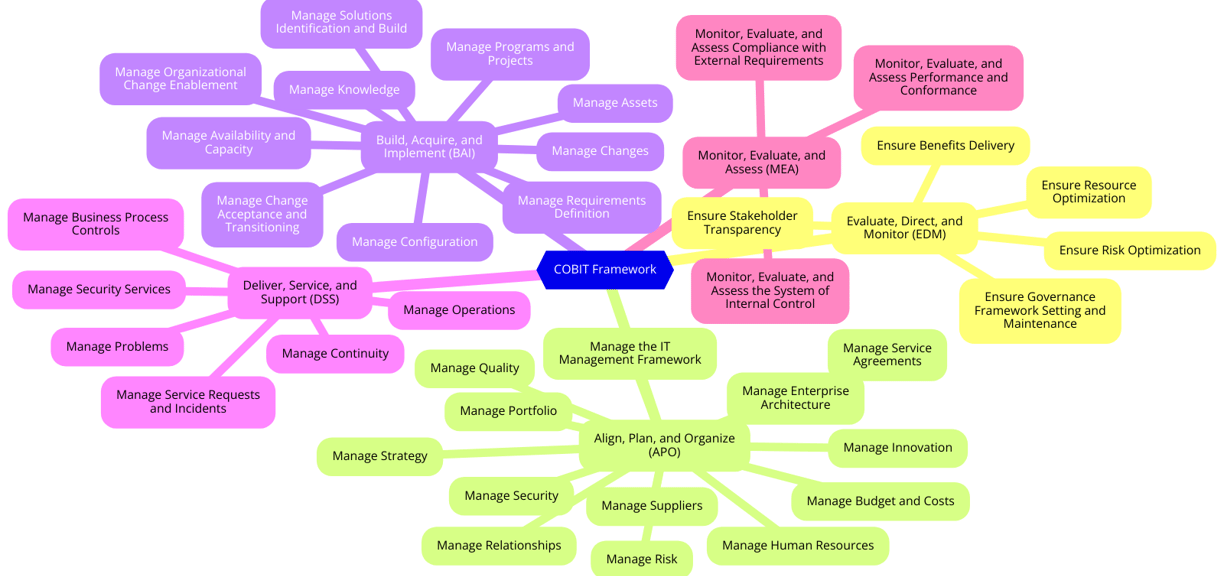COBIT
RISK FRAMEWORKSLATEST POSTFRAMEWORKS
In today’s rapidly evolving digital landscape, organizations face the constant challenge of aligning their IT operations with business goals while ensuring compliance and managing risks. One of the most widely recognized frameworks designed to address these challenges is COBIT. In this blog, we will explore what COBIT is, its core components, principles, benefits, and how it can be effectively implemented within an organization.
What is COBIT?
COBIT, which stands for Control Objectives for Information and Related Technologies, is a comprehensive framework created by ISACA (Information Systems Audit and Control Association) for the governance and management of enterprise IT. Initially released in 1996, COBIT has undergone several updates, with the latest version being COBIT 2019. The framework provides organizations with a structured approach to aligning IT strategy with business objectives, optimizing resources, and ensuring risk management and compliance.
Core Components of COBIT
COBIT consists of several core components that together form a robust governance and management framework:
1. Principles
COBIT is built on five key principles that guide its application:
Meeting Stakeholder Needs: Ensuring that IT delivers value by balancing benefits, risks, and resources.
Covering the Enterprise End-to-End: Integrating IT governance into enterprise governance and covering all functions and processes.
Applying a Single Integrated Framework: Aligning with other relevant standards and frameworks for a comprehensive approach.
Enabling a Holistic Approach: Considering various enablers like processes, structures, culture, and information for effective governance.
Separating Governance from Management: Differentiating between governance (ensuring objectives are achieved) and management (planning, building, running, and monitoring activities).
2. Governance and Management Objectives
COBIT defines a set of governance and management objectives, categorized into domains that cover all aspects of IT governance and management:
Evaluate, Direct, and Monitor (EDM): Focuses on governance objectives.
Align, Plan, and Organize (APO): Covers management processes for planning and organizing IT.
Build, Acquire, and Implement (BAI): Involves processes related to the development and implementation of IT solutions.
Deliver, Service, and Support (DSS): Addresses the delivery and support of IT services.
Monitor, Evaluate, and Assess (MEA): Encompasses processes for monitoring and assessing performance and compliance.
3. Performance Management
COBIT includes a performance management system with maturity models and metrics to evaluate and improve processes. This helps organizations measure their current performance, identify areas for improvement, and track progress over time. The performance management component ensures that organizations can continually enhance their IT governance and management capabilities.
4. Enablers
COBIT identifies seven enablers that are essential for effective governance and management of enterprise IT:
Principles, Policies, and Frameworks: Provide guidance and support.
Processes: Describe activities and practices.
Organisational Structures: Define roles and responsibilities.
Culture, Ethics, and Behavior: Influence organizational attitudes and actions.
Information: Serves as a critical asset.
Services, Infrastructure, and Applications: Provide the required IT capabilities.
People, Skills, and Competencies: Ensure the organization has the necessary talent.
5. Goals Cascade
The goals cascade is a mechanism in COBIT that translates high-level enterprise goals into specific, manageable IT-related goals. This helps ensure that IT activities align with business objectives and that the organization can achieve desired outcomes. The goals cascade links enterprise goals to IT-related goals, enabling a clear understanding of how IT contributes to business success.
Benefits of Implementing COBIT
Adopting COBIT can provide numerous benefits to an organization, including:
1. Improved IT Governance
COBIT provides a clear framework for IT governance, helping organizations align their IT strategy with business goals and ensuring that IT investments deliver value. By defining roles, responsibilities, and processes, COBIT helps establish effective governance structures that drive accountability and decision-making.
2. Enhanced Risk Management
By providing a structured approach to identifying, assessing, and mitigating risks, COBIT helps organizations manage IT-related risks more effectively. This proactive risk management approach minimizes potential threats to the organization’s information assets and ensures business continuity.
3. Regulatory Compliance
COBIT’s comprehensive framework supports compliance with various regulatory requirements, reducing the risk of legal and financial penalties. By following COBIT guidelines, organizations can demonstrate their commitment to compliance and ensure that their IT practices adhere to relevant laws and standards.
4. Operational Efficiency
COBIT’s best practices and process guidelines help streamline IT operations, leading to improved efficiency and reduced costs. By optimizing resource utilization and eliminating redundant processes, organizations can enhance their operational performance and achieve cost savings.
5. Performance Measurement
With its performance management tools, COBIT enables organizations to measure and improve their IT processes, leading to better overall performance. By tracking key performance indicators (KPIs) and using maturity models, organizations can identify areas for improvement and implement targeted strategies to enhance their IT capabilities.
6. Strategic Alignment
COBIT helps ensure that IT initiatives are aligned with the organization’s strategic objectives. By providing a clear linkage between business goals and IT activities, COBIT enables organizations to prioritize IT projects that support their long-term vision and mission.
7. Enhanced Decision Making
COBIT’s structured approach to governance and management provides a solid foundation for informed decision-making. By establishing clear processes, roles, and responsibilities, COBIT ensures that decisions are based on accurate information and aligned with the organization’s strategic goals.
Implementing COBIT
Implementing COBIT involves several key steps:
1. Assess Current State
Conduct a thorough assessment of the organization’s current IT governance and management practices. This involves identifying existing processes, capabilities, and areas that need improvement. The assessment provides a baseline for measuring progress and identifying gaps that need to be addressed.
2. Define Scope and Objectives
Determine the scope of the COBIT implementation and define specific objectives aligned with the organization’s business goals. This includes identifying key stakeholders and their requirements. Clear objectives help guide the implementation process and ensure that the desired outcomes are achieved.
3. Develop a Roadmap
Create a detailed roadmap for implementing COBIT, outlining the necessary steps, resources, and timelines. This should include a plan for training and communication to ensure stakeholder buy-in and support. The roadmap serves as a blueprint for the implementation process, providing a clear path to achieving the organization’s goals.
4. Implement Processes
Start implementing the COBIT processes and practices based on the defined roadmap. This involves establishing governance structures, updating policies, and integrating COBIT principles into daily operations. Effective implementation requires collaboration across the organization and a commitment to following the defined processes.
5. Monitor and Evaluate
Continuously monitor the implementation progress and evaluate the performance of the IT governance and management processes. Use COBIT’s performance management tools to measure outcomes and identify areas for improvement. Regular monitoring ensures that the implementation stays on track and that any issues are promptly addressed.
6. Continuous Improvement
Regularly review and refine the implemented processes to ensure they remain aligned with the organization’s evolving needs and objectives. This involves staying updated with the latest COBIT updates and best practices. Continuous improvement is essential for maintaining the effectiveness of the IT governance framework and adapting to changes in the business environment.
7. Training and Education
Provide ongoing training and education to ensure that all stakeholders understand COBIT principles and practices. This includes training for IT staff, management, and other relevant personnel. Effective training helps build a culture of governance and ensures that everyone is aligned with the organization’s IT goals.
8. Stakeholder Engagement
Engage stakeholders throughout the implementation process to ensure their support and involvement. This includes regular communication, feedback sessions, and involving stakeholders in decision-making processes. Stakeholder engagement is crucial for successful implementation and for gaining buy-in from all parts of the organization.
Conclusion
COBIT is a powerful framework that provides organizations with the tools and guidance needed to achieve effective IT governance and management. By aligning IT strategy with business goals, managing risks, ensuring compliance, and optimizing resources, COBIT helps organizations deliver value through their IT investments. Implementing COBIT involves a structured approach, starting with an assessment of the current state, defining objectives, developing a roadmap, and continuously monitoring and improving processes. With its comprehensive approach and focus on performance measurement, COBIT is an invaluable resource for organizations seeking to enhance their IT governance and management practices.
Whether you are looking to improve operational efficiency, enhance risk management, or ensure regulatory compliance, COBIT offers a proven framework to help you achieve your goals. Embrace COBIT and transform your IT governance and management practices for a more secure, efficient, and aligned enterprise.
By following the COBIT framework, organizations can build a solid foundation for their IT operations, ensuring that they not only meet current business needs but are also well-prepared for future challenges. Implementing COBIT requires commitment and collaboration across the organization, but the benefits of improved governance, risk management, and strategic alignment make it a worthwhile investment.


